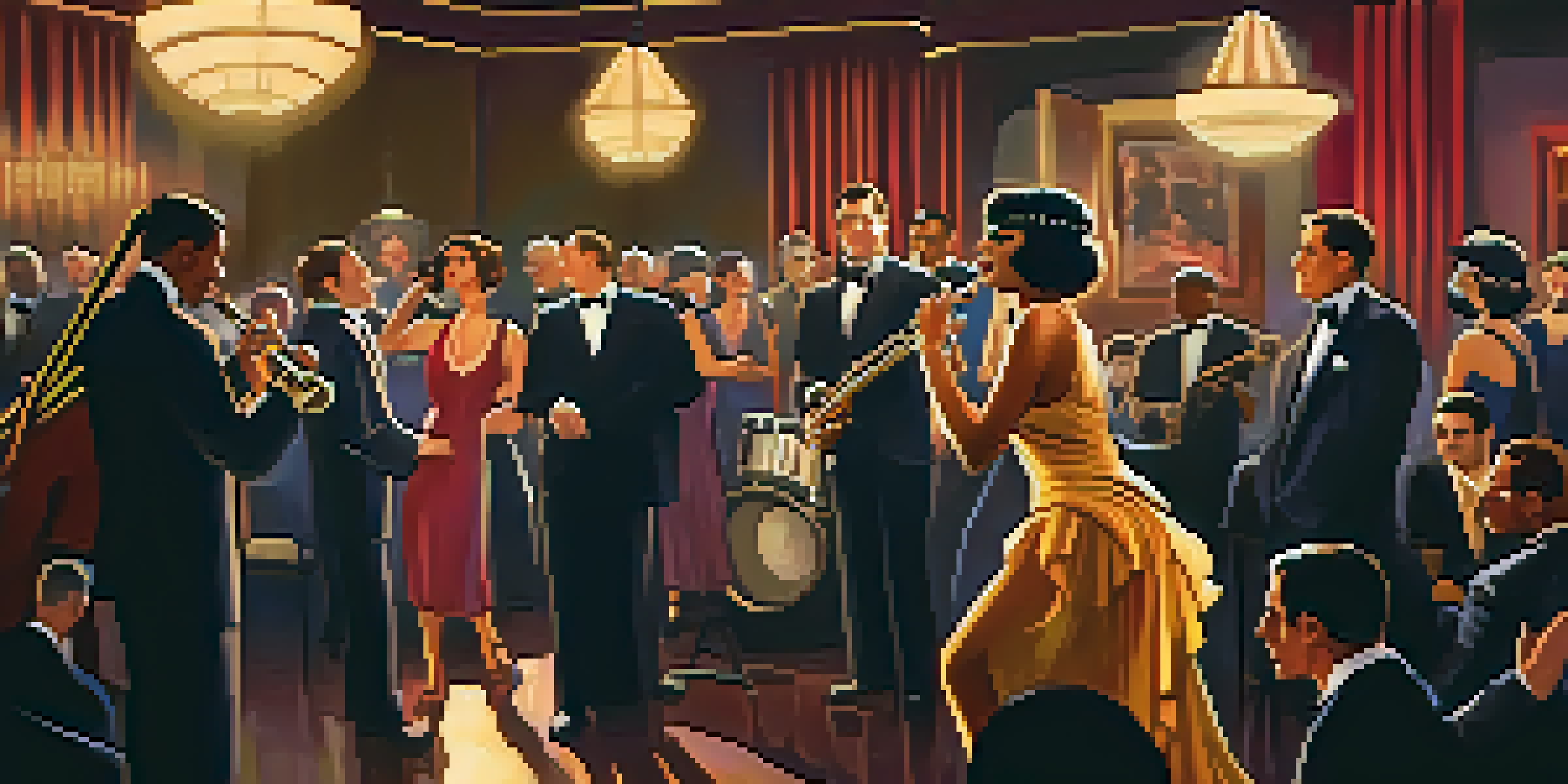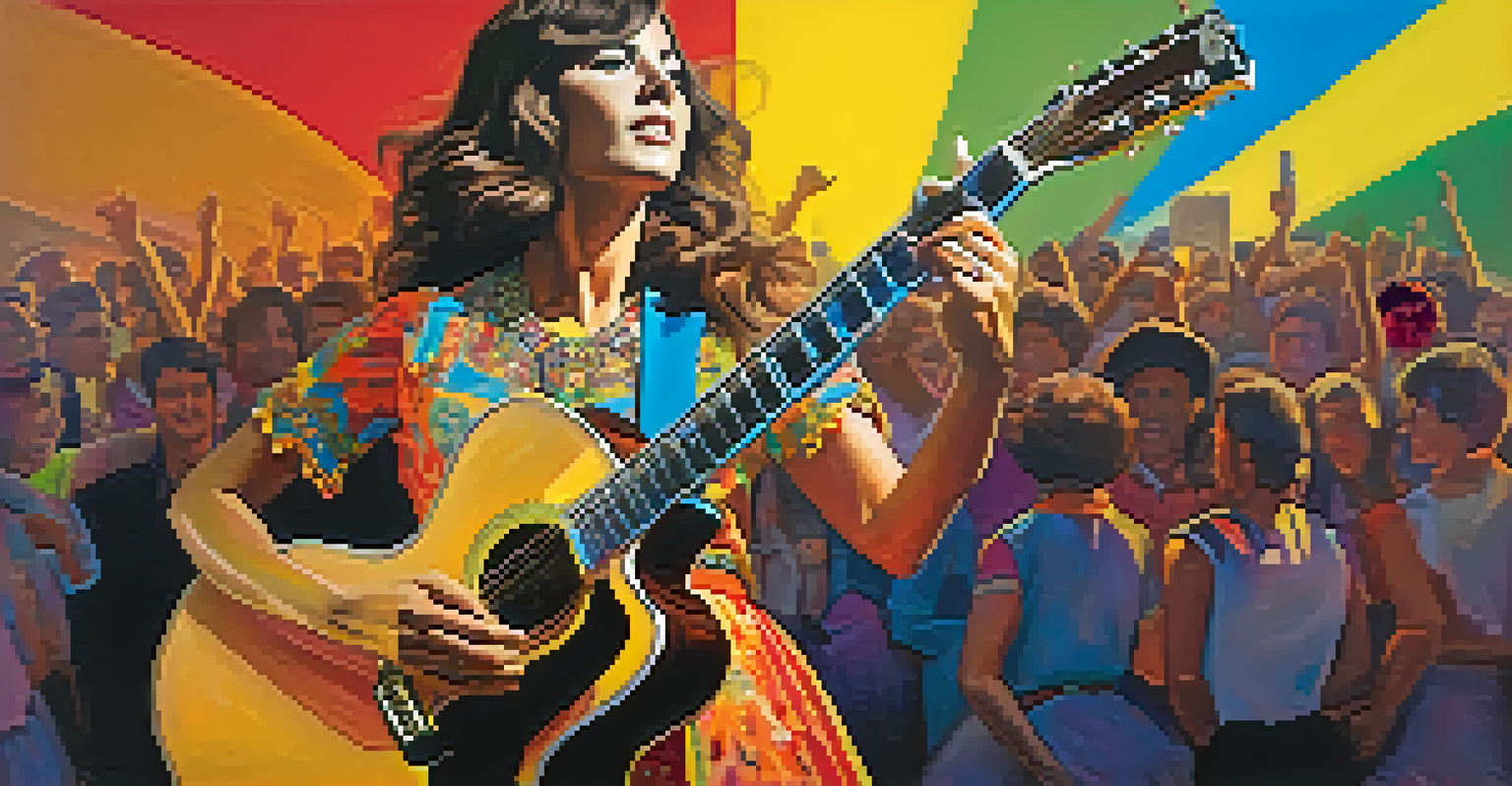Women in Music: A Historical Perspective Through Decades

The Early Days: Women in Music Before the 20th Century
Long before the 20th century, women had a significant presence in music, often behind the scenes. From composers like Fanny Mendelssohn to performers such as Clara Schumann, their contributions laid the groundwork for future generations. Despite societal constraints, many women defied norms to pursue their passion for music, often using pseudonyms to gain recognition.
Women have been the backbone of the music industry, contributing to its evolution and shaping its future.
These early pioneers faced numerous challenges, including lack of access to formal training and limited opportunities to perform publicly. However, their determination shone through, allowing them to create lasting legacies. Their stories highlight the resilience and talent of women in a male-dominated industry, setting the stage for change in the following decades.
As the 19th century progressed, the rise of the salon culture provided women with a platform to showcase their musical abilities. This environment fostered collaboration and creativity among female musicians, further establishing their presence in the music world. The seeds planted during this era would eventually bloom into a more inclusive musical landscape.
The Roaring Twenties: Jazz and the Rise of Female Artists
The 1920s marked a vibrant era for music, with jazz taking center stage and women stepping into the spotlight. Artists like Bessie Smith and Billie Holiday captivated audiences with their powerful voices and emotive performances, paving the way for future female musicians. This decade celebrated a newfound sense of freedom, allowing women to express themselves both personally and artistically.

Jazz clubs became important venues for women to showcase their talent, breaking away from traditional roles. The cultural shift brought about by the flapper movement also influenced music, encouraging women to embrace their individuality and challenge societal norms. With their bold styles and magnetic performances, female jazz musicians played a crucial role in shaping the sound of the era.
Women Pioneered Music's Early Days
Before the 20th century, women like Fanny Mendelssohn and Clara Schumann broke barriers in a male-dominated industry, establishing a legacy that paved the way for future generations.
However, the challenges persisted, as many female artists struggled for equal recognition and pay. Despite these obstacles, their influence on jazz and popular music was undeniable, leaving a lasting impact that would resonate through the decades. The 1920s was a pivotal moment in music history, marking the emergence of women as formidable forces in the industry.
The 1960s and 70s: A Time of Social Change and Musical Revolution
The 1960s and 70s ushered in an era of social upheaval and transformation, and music was at the forefront of this change. Female artists like Janis Joplin, Aretha Franklin, and Joan Baez not only dominated the charts but also became voices of a generation. They used their platforms to address issues such as civil rights and gender equality, resonating with audiences worldwide.
Music is a powerful tool for change, and women are at the forefront of that revolution.
This period saw the rise of genres like rock and folk, where women took on more prominent roles in songwriting and performance. The feminist movement also played a crucial part in empowering women in music, encouraging them to challenge stereotypes and assert their place in the industry. Their contributions helped to redefine what it meant to be a female musician.
However, the road was not without its struggles. Many women faced sexism and were often overlooked in favor of their male counterparts. Nevertheless, the resilience of these artists laid the groundwork for future generations, inspiring countless women to pursue their musical dreams and continue the fight for equality.
The 1980s: Pop Icons and the Explosion of Female Talent
The 1980s brought a wave of female pop icons who dominated the music scene and redefined the industry. Artists like Madonna and Whitney Houston emerged as groundbreaking figures, blending musical talent with a strong sense of style and identity. They paved the way for women to take control of their image and narratives, becoming role models for aspiring musicians.
This era also saw the rise of female-led bands, such as The Bangles and The Go-Go's, who broke through the male-dominated rock scene. Their success showcased the versatility and creativity of women in various music genres, reinforcing the idea that female artists could not only compete but thrive in the industry. The 80s was a time of celebration and empowerment for women in music.
Female Artists Shaped Musical Eras
From jazz in the 1920s to pop icons in the 1980s, women consistently challenged norms and made significant contributions across various genres, asserting their place in music history.
However, the pressures of commercial success often led to a focus on image over artistry. Despite these challenges, many women navigated the complexities of the music business while remaining true to their artistic vision. The legacy of the 1980s continues to influence the music industry today, as female artists draw inspiration from the trailblazers of this vibrant decade.
The 1990s: Diversity and the Rise of Hip-Hop Queens
The 1990s marked a significant shift in the music landscape, with an explosion of diversity in genres and the rise of hip-hop. Female artists like Missy Elliott and Lil' Kim emerged as powerful voices, challenging stereotypes and redefining femininity in the music world. Their bold lyrics and innovative styles set them apart as pioneers in a predominantly male genre.
This decade also saw an increase in female representation across various music styles, from rock to R&B. Artists like Alanis Morissette and TLC used their music to address personal and social issues, resonating with a wide audience. The 90s became a platform for women to express their individuality and advocate for change, both in music and society.
Despite the progress, challenges remained, as many women still faced barriers in gaining recognition and respect. However, the impact of the 90s female artists laid the foundation for a more inclusive music industry. Their influence continues to inspire new generations of musicians, proving that women can and do make a significant mark in every genre.
The 2000s: Breaking Barriers and Expanding Horizons
The 2000s witnessed a remarkable evolution in the music industry, with women breaking barriers and expanding their horizons. Artists like Beyoncé and Lady Gaga emerged as cultural icons, using their platforms to advocate for social justice and gender equality. Their influence extended beyond music, inspiring a generation to embrace self-expression and empowerment.
This decade also saw the rise of digital platforms, allowing female artists to connect with fans directly and gain visibility. The accessibility of music distribution opened doors for diverse voices, showcasing the talents of women from various backgrounds. The 2000s were pivotal in shaping a more inclusive music industry, where women could share their stories and experiences.
Modern Inclusivity in Music Industry
The 2020s have ushered in a new era of inclusivity, with female artists gaining recognition not only as performers but also as influential figures in music production and songwriting.
However, challenges persisted, with issues like sexism and representation still prevalent. Despite these hurdles, female artists continued to thrive, proving that their voices were essential to the music narrative. The impact of the 2000s laid the groundwork for the future, as women in music began to take on more prominent roles both on and off the stage.
The 2010s: Empowerment and the Rise of the Next Generation
The 2010s marked a significant turning point for women in music, as empowerment became a central theme. Artists like Taylor Swift and Adele achieved unprecedented success, using their platforms to advocate for issues close to their hearts. This decade saw a growing recognition of the importance of female voices in shaping the music industry and beyond.
Social media played a crucial role in amplifying women's voices, allowing artists to engage with their audiences in new ways. The #MeToo movement also shed light on the challenges faced by women in the industry, sparking conversations about equality and representation. This shift empowered many female artists to share their stories and demand change.

As new genres and styles emerged, a diverse range of female musicians began to flourish, from Lizzo to Halsey. Their unique perspectives and experiences enriched the music landscape, showcasing the power of storytelling through song. The 2010s set the stage for a brighter future, where women in music continue to redefine boundaries and inspire others.
The 2020s and Beyond: A New Era of Inclusivity
As we enter the 2020s, the music industry is witnessing a new era of inclusivity and diversity. Female artists are not only taking center stage but also becoming influential figures in music production and songwriting. This shift represents a significant change in the narrative, reflecting a broader cultural understanding of the importance of diverse voices.
The ongoing conversation around representation has led to increased visibility for women of color, LGBTQ+ artists, and those from various backgrounds. Platforms like TikTok have democratized music creation, allowing emerging artists to showcase their talents and reach audiences globally. This accessibility has opened doors for unique voices that were previously overlooked.
However, the journey is not yet complete. While progress has been made, continued advocacy for equality and recognition is essential. The future of women in music looks promising, as they continue to break barriers, challenge norms, and inspire future generations to pursue their passions fearlessly.